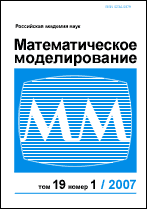|
Numerical analysis of water purification processes in closed loop systems
T. A. Kudryashova, S. V. Polyakov, N. I. Tarasov
Keldysh Institute of Applied Mathematics of RAS
Abstract:
This work is devoted to the development of a numerical approach to modeling the stage
of "fine" filtration of the aquatic environment, following after passing of water through
mechanical filters. At this stage of purification, the aquatic environment is subjected to
electromagnetic or thermal effects. For the analysis of cleaning processes, mathematical
models of fluid flow are proposed, taking into account thermal effects, the evolution of
pollutant concentration with consideration of developed convection-diffusion processes
in the presence of a quasi-static electric field. To describe the flow of an aqueous medium containing particles of solid fine impurities, a quasi-hydrodynamic model is used,
supplemented by the equations of convection-diffusion-reaction. The numerical implementation of the model in the case of three-dimensional Cartesian geometry is based on
the finite volume method on irregular tetrahedral and prismatic meshes and is focused on
the use of parallel computing. As examples of the use of the developed technology of
computer modeling, the problems of electromagnetic cleaning of the aquatic environment
and pollution of the electric heating element are considered. In the first task, the dependence of the pollutant concentration on time is calculated. It demonstrates the cleaning effect and allows us to estimate degree of cleaning depending on the parameters of the
electric field. In the second task, the process of scale formation and subsequent regeneration of the heating element is studied. The calculations performed show how the heating
element is contaminated and how it is cleaned under the influence of hydrochloric acid.
These data make it possible to refine the parameters of perspective closed-cycle plants, in
which cycles of medium heating and regeneration of heating elements alternate.
Keywords:
electrophysical technology, calcium carbonate precipitation, water purification, quasi-hydrodynamic model, mathematical modelling.
Received: 01.11.2022
Revised: 26.12.2022
Accepted: 30.01.2023
Citation:
T. A. Kudryashova, S. V. Polyakov, N. I. Tarasov, “Numerical analysis of water purification processes in closed loop systems”, Matem. Mod., 35:3 (2023), 59–78; Math. Models Comput. Simul., 15:5 (2023), 817–831
Linking options:
https://www.mathnet.ru/eng/mm4450 https://www.mathnet.ru/eng/mm/v35/i3/p59
|

| Statistics & downloads: |
| Abstract page: | 171 | | Full-text PDF : | 45 | | References: | 39 | | First page: | 6 |
|




 Contact us:
Contact us: Terms of Use
Terms of Use
 Registration to the website
Registration to the website Logotypes
Logotypes








 Citation in format
Citation in format 